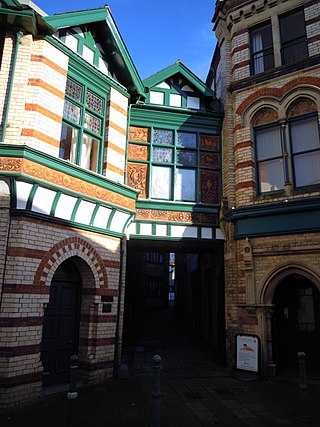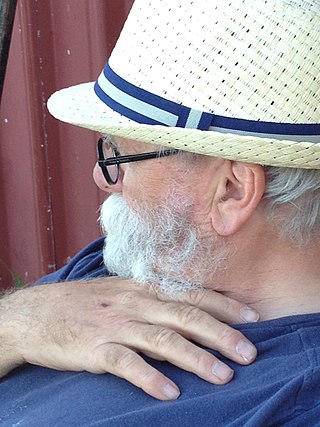
Torquay is a seaside town in Devon, England, part of the unitary authority area of Torbay. It lies 18 miles (29 km) south of the county town of Exeter and 28 miles (45 km) east-north-east of Plymouth, on the north of Tor Bay, adjoining the neighbouring town of Paignton on the west of the bay and across from the fishing port of Brixham.

Bolesławiec is a historic city situated on the Bóbr River in the Lower Silesian Voivodeship, in western Poland. It is the administrative seat of Bolesławiec County, and of Gmina Bolesławiec. As of June 2021, it has a population of 38,280. Founded in the 13th century, the city is known for its long-standing pottery-making tradition and heritage Old Town.

Hornsea Pottery was a business located in the coastal town of Hornsea in the East Riding of Yorkshire, England. They specialized in tableware with elegant contemporary designs.

Creamware is a cream-coloured refined earthenware with a lead glaze over a pale body, known in France as faïence fine, in the Netherlands as Engels porselein, and in Italy as terraglia inglese. It was created about 1750 by the potters of Staffordshire, England, who refined the materials and techniques of salt-glazed earthenware towards a finer, thinner, whiter body with a brilliant glassy lead glaze, which proved so ideal for domestic ware that it supplanted white salt-glaze wares by about 1780. It was popular until the 1840s.

Bovey Tracey is a small town and civil parish in Devon, England, on the edge of Dartmoor, its proximity to which gives rise to the slogan used on the town's boundary signs, "The Gateway to the Moor". It is often known locally as "Bovey". It is about 10 miles south-west of Exeter and lies on the A382 road, about halfway between Newton Abbot and Moretonhampstead. The village is at the centre of the electoral ward of Bovey. At the 2011 census the population of this ward was 7,721.

Studio pottery is pottery made by professional and amateur artists or artisans working alone or in small groups, making unique items or short runs. Typically, all stages of manufacture are carried out by the artists themselves. Studio pottery includes functional wares such as tableware and cookware, and non-functional wares such as sculpture, with vases and bowls covering the middle ground, often being used only for display. Studio potters can be referred to as ceramic artists, ceramists, ceramicists or as an artist who uses clay as a medium.

Barbotine is the French for ceramic slip, or a mixture of clay and water used for moulding or decorating pottery. In English the term is used for three different techniques of decorating pottery, though in all cases mainly for historical works. For clarity, these types are numbered here as A-C.

Torre railway station is a suburban station on the Riviera Line in Torquay, Devon, England. It is 219 miles 12 chains (353 km) measured from London Paddington. The station is managed by Great Western Railway but is not staffed.

Wemyss Ware was a line of pottery first produced in 1882 by Czech decorator Karel Nekola and Fife pottery-owner Robert Heron. The pottery took its name from the Wemyss family, titled incumbents of Wemyss Castle on the east coast of Fife, who were early and enthusiastic patrons of Nekola and Heron's ceramic creations. After being desirable in its own day, the pottery subsequently became extremely popular with collectors. Since 1985, the name has been used by the Griselda Hill Pottery in Ceres, Fife.

The American Terracotta Tile and Ceramic Company was founded in 1881; originally as Spring Valley Tile Works; in Terra Cotta, Illinois, between Crystal Lake, Illinois and McHenry, Illinois near Chicago by William Day Gates. It became the country's first manufactury of architectural terracotta in 1889. The production consisted of drain tile, brick, chimney tops, finials, urns, and other economically fireproof building materials. Gates used the facilities to experiment with clays and glazes in an effort to design a line of art pottery which led to the introduction of Teco Pottery. American Terra Cotta's records are housed at the University of Minnesota and include original architectural drawings.

Coffinswell is a small village in South Devon, England, just off the A380, the busy Newton Abbot to Torquay road. It lies within Teignbridge District Council.
The South Devon Football League, known under a sponsorship arrangement as the TCSSDFL, is a football competition based in England. Its top division, the Premier Division, sits outside of the English football league system although it is a feeder to the Devon Football League which sits at Step 11 of this system. There are five divisions in the league. The SDFL's primary cup competition is the Herald Cup. It is a simple knockout competition featuring all SDFL clubs.

Brannam Pottery was a British pottery started by Thomas Backway Brannam in Barnstaple, Devon, England, in 1848. It later became part of the "rustic" wing of the art pottery movement.
Red Wing pottery refers to American stoneware, pottery, or dinnerware items made by a company initially set up in Red Wing, Minnesota, in 1861 by German immigrant John Paul, which changed its names several times until finally settling on Red Wing Potteries, Inc. in 1936. The pottery factory that started in 1861 continues to the present day under the names of Red Wing Pottery and Red Wing Stoneware. There was a respite in production when Red Wing Pottery Sales, Inc. had a strike in 1967 causing them to temporarily cease trading. The company still makes both zinc/Bristol glazed products as well as salt-glazed, hand-thrown, kiln fired items.

The Aller Vale Pottery was formed in 1865 on the northern edge of the village of Kingskerswell in South Devon, England on the likely site of a medieval pottery. It became well known for the creation of art pottery at the end of the 19th century and gained Royal patronage, but declined thereafter, closing on this site in about 1924. The name continued in use until 1962 related to the production of mass-produced motto ware for the tourist market.

Gladding, McBean is a ceramics company located in Lincoln, California. It is one of the oldest companies in California, a pioneer in ceramics technology, and a company which has "contributed immeasurably" to the state's industrialization. During the heyday of architectural terra cotta, the company "dominated the industry in California and the Far West."

California pottery includes industrial, commercial, and decorative pottery produced in the Northern California and Southern California regions of the U.S. state of California. Production includes brick, sewer pipe, architectural terra cotta, tile, garden ware, tableware, kitchenware, art ware, figurines, giftware, and ceramics for industrial use. Ceramics include terra cotta, earthenware, porcelain, and stoneware products.

The Bovey Tracey Potteries were a collection of potteries in the Bovey Tracey area of Devon, based on the clay from the Bovey Basin. Pottery making developed in the area developed on an industrial scale from around 1750 and lasted for around 200 years under various owners and names.

American art pottery refers to aesthetically distinctive hand-made ceramics in earthenware and stoneware from the period 1870-1950s. Ranging from tall vases to tiles, the work features original designs, simplified shapes, and experimental glazes and painting techniques. Stylistically, most of this work is affiliated with the modernizing Arts and Crafts (1880-1910), Art Nouveau (1890–1910), or Art Deco (1920s) movements, and also European art pottery.

Roger Michell was a British studio potter, artist, illustrator, poet and writer. Although foremost a potter, his deep insight, curiosity and his singular skills enabled him to work across a range of disciplines. He was a prolific reader, often reading several books a week. His mind was constantly working on future projects, he had a vivid and complex imagination which was evident in his work. He was most known for designing Walking Ware, a tea set on legs with over-sized Mary Jane shoes. During the nineteen seventies and eighties, thousands of these tea sets were sold, either hand made from Lustre Pottery studio or manufactured by Carltonware in Stoke-on-Trent.




















